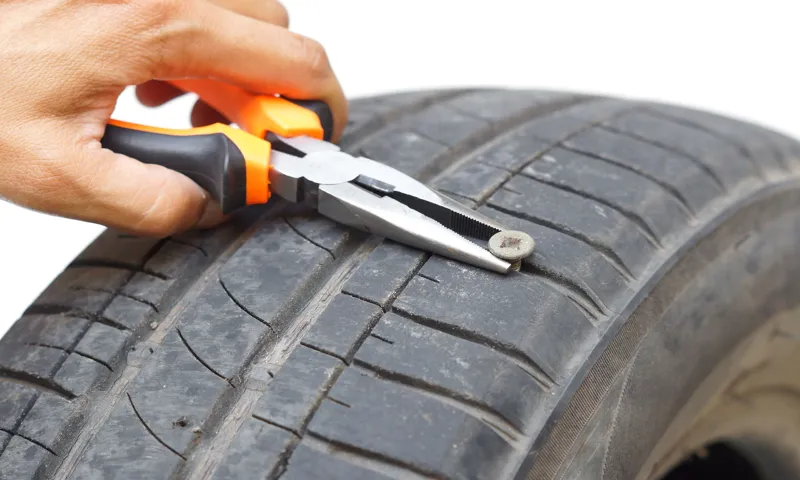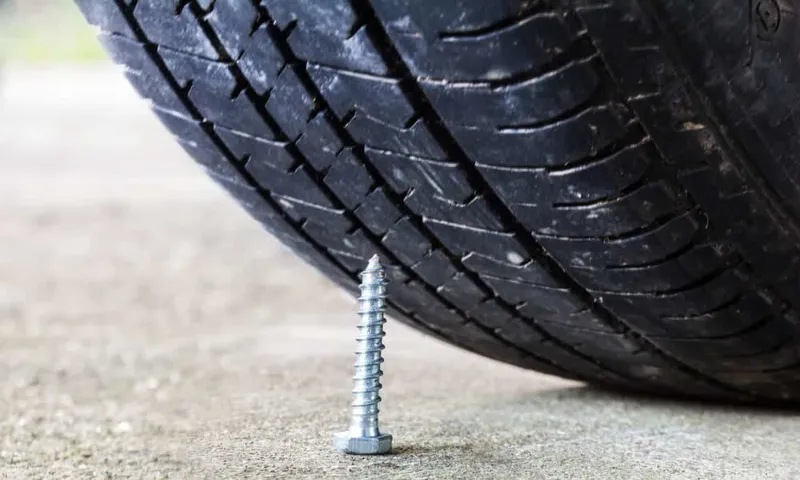Have you ever been cruising down the road, enjoying a beautiful day, only to hear a loud POP followed by a sinking feeling? Next thing you know, you’re on the side of the road staring at a flat tire with a nail sticking out of it. It’s frustrating, inconvenient, and can be quite costly. But what are the odds of it happening? Is it just bad luck, or is there more to it? Let’s take a closer look at the likelihood of getting a nail in your tire and what factors increase your chances.
Introduction
If you’ve ever driven over a construction site or a poorly maintained road, you may have wondered what the chances are of getting a nail in your tire. Unfortunately, the chances are higher than we’d like them to be. Nails, screws, and other sharp objects are all too common on roadsides and can easily find their way onto the pavement.
While modern tires are designed to resist punctures, it only takes a small nail or screw to do some significant damage. In some cases, a nail can puncture the tire and cause a slow leak, making it impossible to drive on. It’s always best to drive carefully and avoid driving over obstacles that could cause damage to your tires.
If you do end up with a nail in your tire, don’t drive on it, as it could lead to a complete blowout. Instead, have your tire repaired or replaced as soon as possible.
Statistics on Tire Punctures
Tire punctures are an all too common problem that many drivers face on a regular basis. Despite advances in technology and improved tire construction, punctures can still happen for a variety of reasons. Statistically speaking, tire punctures occur more frequently in urban areas than in rural ones due to the higher levels of traffic and heavier vehicle loads.
Moreover, data shows that the vast majority of punctures are caused by foreign objects such as nails, glass, or other sharp debris on the road, which can easily penetrate the soft rubber of a tire. Unfortunately, a single puncture can rapidly lead to a flat tire, and if not addressed promptly, can potentially cause further extensive damage to the wheel or even the vehicle itself. It’s important for drivers to be aware of these statistics and take preventative measures, such as regularly checking the condition of their tires and avoiding areas with high levels of debris.

Factors That Affect the Risk of Tire Punctures
Tire punctures are frustrating, and they can be dangerous, especially if they happen on a busy highway. Several factors can increase the risk of tire punctures. One of the most common factors is road conditions.
Poor road conditions, including potholes and debris, can cause small cuts in the tire, leading to punctures. Another factor that can increase the risk of tire punctures is the age of the tire. As tires age, they become more vulnerable to punctures, and the risk of a puncture increases significantly.
Proper tire maintenance can help reduce the risk of punctures. This includes checking tire pressure regularly, rotating tires, and inspecting the tires for cuts or tears. By staying on top of maintenance and being cautious on the road, drivers can reduce the risk of a tire puncture.
How to Reduce Your Risk of Getting a Nail in Your Tire
“What are the chances of getting a nail in your tire?” Well, unfortunately, the odds aren’t actually in our favor. With the amount of debris on roads today, it’s not uncommon to come across nails, screws, and other sharp objects that can easily puncture our tires. However, there are some things we can do to reduce our risk of getting a nail in our tire.
One is to avoid driving over construction sites or areas where there is a lot of debris on the road. Another is to keep our tires properly inflated, as underinflated tires are more susceptible to punctures. Additionally, regular tire maintenance and inspections can help detect any nails or punctures before they result in a flat tire.
While there’s no foolproof way to completely eliminate the risk of getting a nail in our tire, taking these precautionary measures can definitely help reduce the chances and keep us safer on the road.
Tips for Avoiding Tire Punctures
As a driver, getting a punctured tire can be a massive inconvenience. Not only does it put a dent in your busy schedule, but it can also cost you a lot of money in repairs or even a new tire. However, there are steps you can take to reduce the risk of getting a nail in your tire.
Firstly, try and avoid driving over unknown debris or in construction zones where nails and screws are often present. Secondly, maintain the correct tire pressure and keep your tires properly inflated to reduce the risk of a blowout. Thirdly, regularly check your tires for any signs of wear and tear or punctures.
Lastly, invest in high-quality tires with reinforced sidewalls that can handle the wear and tear of daily driving. By implementing these simple tips, you can significantly reduce the chances of getting a nail in your tire and keep your vehicle running safely on the road.
How to Check Your Tires for Damage
If you want to reduce your risk of getting a nail in your tire, there are a few things you can do. First, regularly check your tires for damage. This includes looking for any punctures or cracks in the sidewall.
You can use a penny to check your tire tread – if you can see the top of Lincoln’s head, it’s time for new tires. Another way to reduce the risk is by being cautious when driving. Try to avoid debris on the road or construction sites where nails and other sharp objects may be present.
Additionally, make sure to keep the air pressure in your tires at the recommended level. This not only helps to prevent punctures but also improves overall tire performance and can even save you money on gas. By taking these steps, you can reduce the chances of getting a nail in your tire and avoid the hassle and cost of replacing it.
When to Replace Your Tires
As a driver, one of the last things you want to deal with is a flat tire. Not only is it a hassle, but it can also be dangerous if ignored. While there are many factors that can cause a tire to go flat, one of the most common culprits is a nail or screw on the road.
To reduce your risk of getting a nail in your tire, be mindful of where you’re driving. Avoid areas with construction or debris, and be cautious when parking near areas that may have loose screws or nails. Additionally, make sure to regularly inspect your tires for any signs of damage, such as bulges or tears.
By taking these preventative measures, you can reduce your risk of dealing with a flat tire. Remember, safety should always be your top priority when behind the wheel.
Conclusion
As much as we may try to avoid it, the odds of getting a nail in our tire seems to be a roll of the die. Whether it’s a result of unlucky road conditions or just plain bad luck, it’s a problem that will continue to puncture our plans. But fear not, for with the right tools and know-how, we can always patch up the situation and keep on rolling down the road of life.
“
FAQs
How often do nails puncture tires?
Nails, screws, and other sharp objects can puncture tires at any time. It is difficult to determine an exact frequency, but it is common enough for motorists to experience a flat tire due to a nail.
Are there any ways to prevent getting a nail in my tire?
Avoiding construction sites, maintaining proper tire pressure and inspecting tires on a regular basis are ways to prevent nails from puncturing your tire.
What should I do if I get a nail in my tire?
If you notice a nail in your tire, you should avoid driving on it since it can cause further damage. Instead, replace the tire with a spare or contact a professional to repair or replace the tire.
How much does it cost to repair or replace a tire with a nail puncture?
The cost of repairing or replacing a tire with a nail puncture depends on the severity of the damage, the type of tire, and the labor cost. On average, it can cost between $10 to $30 for a repair and $100 to $300 for a replacement tire.
Can a nail puncture be patched or repaired?
In some cases, a nail puncture can be patched or repaired using a special plug that seals the hole. However, if the damage is severe or the nail is located in the sidewall, the tire will need to be replaced.
What are the signs of a nail puncture in a tire?
Symptoms of a nail puncture include a slow leak, hissing sound, or a sudden drop in tire pressure. It can also cause vibration and steering issues when driving.
Can driving on a tire with a nail puncture cause further damage?
Yes, driving on a tire with a nail puncture can cause further damage to the tire, wheel, and suspension system. It increases the risk of a blowout and can compromise the overall safety of the vehicle.

